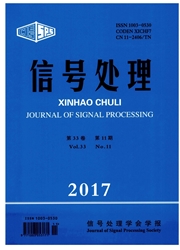

 中文摘要:
中文摘要:
异构网络中终端的移动特性是无线资源分配的一个重要因素,本文给出了一种终端的角度移动模型,分析了该模型下终端移动的方向角特点。根据终端移动的方向角特点,推导了用户在固定的时间间隔T内运动方向不变时的切换率闭合公式,并将时间间隔T趋于零时的切换率的理论极限值作为一个特例,从切换率的理论极限值可以明显看出,切换率与用户分布密度、用户移动速度以及小区半径之间的关系,通过切换率的计算说明了在一定条件下,小区内用户数是动态平衡的。然后进一步推导了异构网络中垂直切换率的闭合公式,并仿真证明了理论分析的正确性。仿真结果表明,在终端移动方向改变频繁、终端移动速率很低或者小区半径足够小时,可以利用切换率的理论极限值来近似实际切换率,这样可以有效降低理论计算切换率的复杂度。
 英文摘要:
英文摘要:
Terminal mobility in heterogeneous networks is a key factor for wireless resource allocating. The paper pres- ents an angle mobility model for the terminal, and analyzes the characteristic of the direction angle for terminal mobility in this model. According to the characteristic of the direction angle for terminal mobility, the theoretical closed-formula is de- rived for vertical handoff rate in the condition that users' moving direction is unchanging in the fixed time interval T. And the theoretical ultimate value of handoff rate is taken as a special case when the fixed time interval T tends to zero. It can be clearly demonstrated that the relationship between handoff rate and the users' distributed density, moving speed, cell radius from the theoretical ultimate value of handoff rate. The calculation result of handoff rate illustrates that the number of cell' s users is dynamic equilibrium under certain conditions. Then it further deduces the closed-formula of vertical handoff rate in heterogeneous networks, and reveals the validity of theoretical analysis by simulation. The simulation results show that the theoretical ultimate value of handoff rate can be used to approximate to the practical handoff rate with terminal' s frequently changing moving direction, low moving speed or small enough cell radius, thus it can effectively reduce the complexity of theoretical calculation for handoff rate.
 同期刊论文项目
同期刊论文项目
 同项目期刊论文
同项目期刊论文
 Interference Coordination Method Spectrum Allocation Based on Graph Theory In Two-tier Cellular Netw
Interference Coordination Method Spectrum Allocation Based on Graph Theory In Two-tier Cellular Netw Radio Resource Management Scheme for Heterogeneous Wireless Networks based on Access Proportion Opti
Radio Resource Management Scheme for Heterogeneous Wireless Networks based on Access Proportion Opti A new algorithm of spectrum allocation based on the balance between supply and demand in cognitive r
A new algorithm of spectrum allocation based on the balance between supply and demand in cognitive r Joint Optimization Methodsfor Non-convex Resource Allocation Problems of Decode-and-Forward Relay Ba
Joint Optimization Methodsfor Non-convex Resource Allocation Problems of Decode-and-Forward Relay Ba Joint Optimization Scheme for Power Allocation and Subcarrier Pairing inOFDM-Based Multi-Relay Netwo
Joint Optimization Scheme for Power Allocation and Subcarrier Pairing inOFDM-Based Multi-Relay Netwo Performance Analysis of the Primary User in theSecondary User Relay Assisted Spectrum Sharing Networ
Performance Analysis of the Primary User in theSecondary User Relay Assisted Spectrum Sharing Networ Resource Allocation for Decode-and-Forward Relaying Assisted Multi-cell Orthogonal Frequency Divisio
Resource Allocation for Decode-and-Forward Relaying Assisted Multi-cell Orthogonal Frequency Divisio A Joint Resource Allocation Scheme for Relay Enhanced Multi-cell Orthogonal Frequency Division Multi
A Joint Resource Allocation Scheme for Relay Enhanced Multi-cell Orthogonal Frequency Division Multi Cooperative modulation recognition method based on multi-type feature parameters and improved DS evi
Cooperative modulation recognition method based on multi-type feature parameters and improved DS evi An Adaptive BandwidthAllocation Strategy for Multiuser Multi-access Video Communication over Heterog
An Adaptive BandwidthAllocation Strategy for Multiuser Multi-access Video Communication over Heterog Joint Optimization Scheme for Power Allocation and Subcarrier Pairing in OFDM-Based Multi-Relay Netw
Joint Optimization Scheme for Power Allocation and Subcarrier Pairing in OFDM-Based Multi-Relay Netw Joint energy-efficient powerallocation and subcarrier pairing in orthogonal frequency divisionmultip
Joint energy-efficient powerallocation and subcarrier pairing in orthogonal frequency divisionmultip An Energy-Aware Routing Protocol for Mobile Ad Hoc Networks Based on Route Energy Comprehensive Inde
An Energy-Aware Routing Protocol for Mobile Ad Hoc Networks Based on Route Energy Comprehensive Inde 期刊信息
期刊信息
